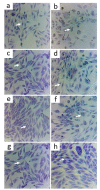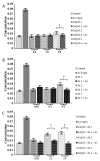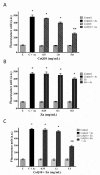Antioxidant Effect of Coenzyme Q10 in the Prevention of Oxidative Stress in Arsenic-Treated CHO-K1 Cells and Possible Participation of Zinc as a Pro-Oxidant Agent
- PMID: 36014770
- PMCID: PMC9412518
- DOI: 10.3390/nu14163265
Antioxidant Effect of Coenzyme Q10 in the Prevention of Oxidative Stress in Arsenic-Treated CHO-K1 Cells and Possible Participation of Zinc as a Pro-Oxidant Agent
Abstract
Oxidative stress is an imbalance between levels of reactive oxygen species (ROS) and antioxidant enzymes. Compounds with antioxidant properties, such as coenzyme Q10 (CoQ10), can reduce cellular imbalance caused by an increase in ROS. CoQ10 participates in modulating redox homeostasis due to its antioxidant activity and its preserving mitochondrial functions. Thus, the present study demonstrated the protective effects of CoQ10 against oxidative stress and cytotoxicity induced by arsenic (As). Antioxidant capacity, formation of hydroperoxides, generation of ROS, and the effect on cellular viability of CoQ10, were investigated to determine the protective effect of CoQ10 against As and pro-oxidant compounds, such as zinc. Cell viability assays showed that CoQ10 is cytoprotective under cellular stress conditions, with potent antioxidant activity, regardless of the concentration tested. Zn, when used at higher concentrations, can increase ROS and show a pro-oxidant effect causing cell damage. The cytotoxic effect observed for As, Zn, or the combination of both could be prevented by CoQ10, without any decrease in its activity at cellular levels when combined with Zn.
Keywords: Zinc; antioxidants; coenzyme Q10; free radical; oxidative stress.
Conflict of interest statement
The authors declare no conflict of interest.
Figures








Similar articles
-
Protective Effects of Coenzyme Q10 Against Hydrogen Peroxide-Induced Oxidative Stress in PC12 Cell: The Role of Nrf2 and Antioxidant Enzymes.Cell Mol Neurobiol. 2016 Jan;36(1):103-11. doi: 10.1007/s10571-015-0224-4. Epub 2015 Jun 14. Cell Mol Neurobiol. 2016. PMID: 26072159 Free PMC article.
-
Coenzyme Q10 protects isolated human blood cells from TiO2 nanoparticles induced oxidative/antioxidative imbalance, hemolysis, cytotoxicity, DNA damage and mitochondrial impairment.Mol Biol Rep. 2021 Apr;48(4):3367-3377. doi: 10.1007/s11033-021-06394-x. Epub 2021 May 19. Mol Biol Rep. 2021. PMID: 34009565
-
Coenzyme Q10 supplementation acts as antioxidant on dystrophic muscle cells.Cell Stress Chaperones. 2019 Nov;24(6):1175-1185. doi: 10.1007/s12192-019-01039-2. Epub 2019 Oct 16. Cell Stress Chaperones. 2019. PMID: 31620981 Free PMC article.
-
Coenzyme Q10 Supplementation for the Reduction of Oxidative Stress: Clinical Implications in the Treatment of Chronic Diseases.Int J Mol Sci. 2020 Oct 23;21(21):7870. doi: 10.3390/ijms21217870. Int J Mol Sci. 2020. PMID: 33114148 Free PMC article. Review.
-
Coenzyme Q10, a cutaneous antioxidant and energizer.Biofactors. 1999;9(2-4):371-8. doi: 10.1002/biof.5520090238. Biofactors. 1999. PMID: 10416055 Review.
Cited by
-
Can coenzyme Q10 alleviate the toxic effect of fenofibrate on skeletal muscle?Histochem Cell Biol. 2023 Aug;160(2):147-158. doi: 10.1007/s00418-023-02205-5. Epub 2023 Jun 4. Histochem Cell Biol. 2023. PMID: 37270716 Free PMC article.
-
Investigating the Hepatoprotective Properties of Mulberry Leaf Flavonoids against Oxidative Stress in HepG2 Cells.Molecules. 2024 May 31;29(11):2597. doi: 10.3390/molecules29112597. Molecules. 2024. PMID: 38893475 Free PMC article.
-
The Application and Molecular Mechanisms of Mitochondria-Targeted Antioxidants in Chemotherapy-Induced Cardiac Injury.Curr Issues Mol Biol. 2025 Mar 7;47(3):176. doi: 10.3390/cimb47030176. Curr Issues Mol Biol. 2025. PMID: 40136430 Free PMC article. Review.
-
Novel Strategies in the Early Detection and Treatment of Endothelial Cell-Specific Mitochondrial Dysfunction in Coronary Artery Disease.Antioxidants (Basel). 2023 Jun 28;12(7):1359. doi: 10.3390/antiox12071359. Antioxidants (Basel). 2023. PMID: 37507899 Free PMC article. Review.
-
Antioxidants in cancer therapy mitigating lipid peroxidation without compromising treatment through nanotechnology.Discov Nano. 2025 Apr 24;20(1):70. doi: 10.1186/s11671-025-04248-0. Discov Nano. 2025. PMID: 40272665 Free PMC article. Review.
References
-
- Hassan S.Z., Gheita T.A., Kenawy A.S., Fahim A.T., El-sorougy I.M., Abdou M.S. Oxidative stress in systemic lupus erythematosus and rheumatoid arthritis patients: Relationship to disease manifestations and activity. Int. J. Rheum. Dis. 2011;14:325–331. doi: 10.1111/j.1756-185X.2011.01630.x. - DOI - PubMed
MeSH terms
Substances
LinkOut - more resources
Full Text Sources
Medical
Research Materials

